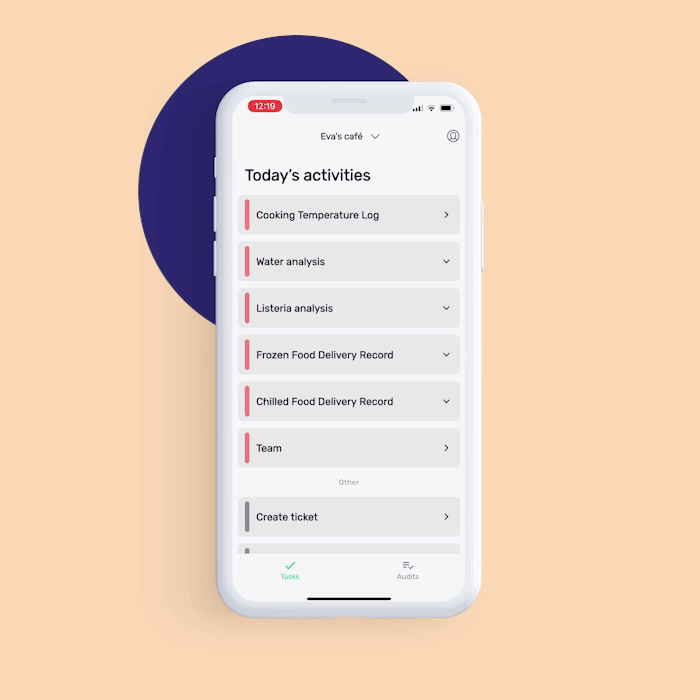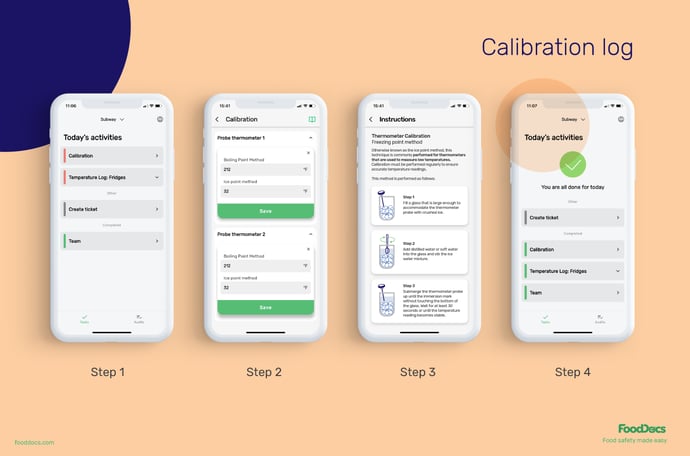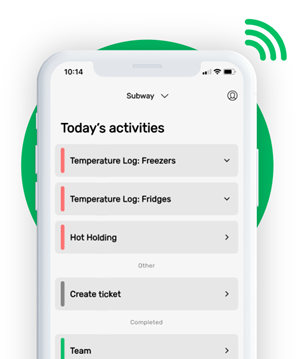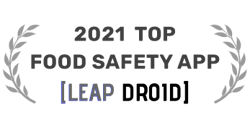US SALMON INTERNAL TEMPERATURE CHART | FREE TEMPLATE
Use our free poster for Salmon Internal Temperature Chart.
Just enter your email and download the template.

Salmon temperature chart: From rare to well-done
- The Salmon Temperature Chart is a free tool that you can download and print to help your employees prepare salmon dishes. The main chart also includes a Salmon Sous Vide Temperature Chart and Smoked Salmon Temperature Chart.1
- Cooking salmon accurately requires monitoring of the internal temperature using a calibrated food thermometer and a monitoring log.
- Cooking salmon to the correct temperature of 145°F ensures that any potentially present harmful bacteria or parasite is eliminated.
- The final internal temperature of salmon will determine its texture and flavor.
- Salmon can be cooked in five different doneness levels with different internal target temperature ranges:
- Rare - 120°F
- Medium-rare - 125°F
- Medium - 130°F
- Medium-well - 135°F to 140°F
- Well-done - 140°F to 145°F
- Use FoodDocs' smart Food Safety Management System with intuitive solutions to efficiently monitor temperature readings and calibration settings.
- How to use FoodDocs' free Salmon Cooking Temperature Chart?
- What temp to cook salmon?
- Why is the cooked salmon temp important?
- How to measure salmon cook temp?
- Determining Doneness using the Salmon Temperature Chart
- Download and use Smoked Salmon Temperature Chart
- Download and use Salmon Sous Vide Temperature Chart
How to use FoodDocs' free Internal Temp of Salmon Chart
- Insert your email in the field provided and hit "Download" to get the free chart.
- Find the downloaded full-quality file from your downloads folder. Print the chart in full quality.
- Post the chart on the wall of your kitchen, preferably near the working area for preparing salmon.
- Explain the importance of cooking salmon to a safe internal temperature and how to use the chart for salmon cooking.
- Check out our other free tools and different food temperature charts from our Template hub.
What temp to cook salmon?
Why is the cooked salmon temp important?
- Food safety. The internal target temperature of 145°F was established based on the safest temperature that will effectively kill any harmful bacteria or parasites that may be present in a single portion of raw salmon meat.
- Food quality. The final internal temperature of fresh salmon affects the texture and flavor of salmon. Overcooking results in a dry, tough, and rubbery texture on fish with less flavor. On the other hand, undercooking salmon results in soft and raw meat.
- Customer preference. Salmon meat can be prepared in different levels of doneness. Depending on the customer preference, salmon can be served from a rare to well-done level of cooking. The final characteristics of the salmon significantly vary based on the internal temp of the meat.
- Cooking methods. Different cooking methods, such as sous vide, smoking, grilling, and baking, require different internal temperatures to achieve different cooking characteristics. For example, frying salmon requires a higher internal temperature to get a crispy skin, which is the main appeal of pan-seared salmon pieces.
How to measure salmon cook temp?
- Ensure that the food thermometer you are using is sanitized and calibrated.
- Insert the thermometer probe into the thickest part of the salmon filet. Thicker fillets will reach the target temperature with a longer cooking time.
- Wait for the temperature reading to stabilize.
- If the desired internal temperature is not yet reached, allow the meat to cook a bit more. Repeat the process and log temperature readings.
- Once the target temperature for the desired level of doneness is reached, allow the cooked salmon meat to rest for about 3-5 minutes.
Determining Doneness using the Salmon Internal Cook Temperature Chart
- Rare. Cooked to an internal temperature of 120°F. Rare salmon is characterized by deep pink flesh at the center, with a seared exterior. Serving rare salmon requires food handlers to advise customers of the associated risks for safety reasons.
- Medium-rare. Cooked to an internal temperature of 125°F. Medium-rare salmon has a pink center with a fully cooked exterior and skin.
- Medium. Cooked to 130°F. Medium-cooked salmon has a very light pink center with a fully cooked exterior. This level of doneness is popular for its flavors and texture.
- Medium-well. The salmon meat is cooked to 135°F to 140°F. Medium-well salmon is flakey and firm, with almost no pink color at the center.
- Well-done. Well-done salmon is cooked to an internal temperature of 140°F to 145°F. At this level of doneness, the salmon meat is fully cooked with a creamy white color.
Download and use Smoked Salmon Internal Temp Chart
.png?width=794&height=680&name=Salmon_smoked_temp_chart%20(1).png)
Downloadable Smoked Salmon Temperature Chart
Smoking is a popular way of preparing individual fillets of salmon. It adds a unique smokey flavor and tenderizes the piece of salmon. Smoking uses low to medium-high heat and a long cooking time to achieve its delicate characteristics. This process can be used as an additional preparation step for other cooking techniques as well, such as when baking salmon.
Use our free downloadable Smoking Salmon Temperature Chart to guide your employees on how to reach a particular level of doneness and correct temperature when smoking salmon.
Download and use Salmon Sous Vide Temperature Chart
Sous vide is a cooking process that heats marinated food at a constant temperature using a water bath. The process of cooking delicious recipes of salmon using the sous vide method involves submerging the salmon fillet in the water while wrapped in a sealed bag. This process slow-cooks the meat at a consistent temperature. The process preserves the maximum flavor, moisture, and tender texture of the salmon filet, and it can be used for serving undercooked salmon meat, such as for sashimi.
Achieving the internal target temperature using this method is fairly easy as the machine can consistently maintain the temperature of the water bath. Use our free downloadable Salmon Sous Vide Temperature Chart for more precise and consistent cook on your salmon sous vide dishes.
.png?width=794&height=756&name=Salmon_sous_vide_temp_chart%20(1).png)
Downloadable Salmon Sous Vide Temperature Chart
Using smart monitoring for cooking salmon
The main key to ensuring precise salmon cooking is consistent and accurate monitoring. Both food safety and the final quality of your product rely upon your team being able to monitor the internal temperature of your food accurately.
Use FoodDocs' smart Food Safety Management System with intuitive solutions. Powered by artificial intelligence, our software can automatically generate powerful monitoring log templates that can be further improved through customizations.
Record and monitor the proper temperature of your salmon dishes every time you prepare them using the automatically generated, customizable monitoring logs and checklists from our software.
Below are the essential logs and checklists that you can use to support proper cooking and safe preparation of your salmon dishes:
- Cooking temperature log. Use this monitoring task to record the internal cooking temperature of your salmon, whether for smoking, baking, grilling, or frying.

Cooking temperature log from FoodDocs software
- Thermometer calibration log. Ensure that all meat thermometers used in monitoring cooking temperature in your kitchen are properly calibrated, and monitor calibration readings using this task.

Thermometer calibration log from FoodDocs software
- Employee sanitation checklist. Before cooking, ensure that all employees follow strict hygiene protocols to avoid any potential contamination in your salmon dishes.
Optimize cooking temperature monitoring with our prefill solutions. Employees need to stay focused on the piece of salmon or food item they are cooking. Manually recording the temperature reading takes time and promotes contamination in the food being prepared. Use our prefilling solution that automatically logs temperature readings into the digital logs based on your previous data. So, your employees would only have to verify the data and focus more on cooking.
Temperature monitoring is also a critical and time-sensitive task. You can use our smart notification system through our Food Safety App to remind your employees whenever they need to monitor cooking temperature. For example, if you are baking a salmon dish, our smart notification system can send alerts reminding your employee to check the correct salmon temperature for baking salmon.
In addition to smart solutions that can help you consistently monitor critical food safety tasks, our smart software also offers features that can help you manage your team and operations more efficiently.
- Remotely monitor and verify if food safety tasks are done correctly through our real-time dashboard. This feature gives you an overview of your everyday food safety operations and their status. The dashboard will also reflect in case a non-conformance on temperature reading is detected. Save at least 20% of your time managing your team on-site.
- Store and organize all temperature reading logs, checklists, and certificates in one cloud storage. Access all food safety tasks and share them with food safety inspectors for a more efficient evaluation.
Setting up our smart Food Safety Management System only takes 15 minutes. With the help of artificial intelligence and a machine-learning program, our system can generate the essential task and checklist templates for you.
Let your customers experience your commitment to food safety and quality by serving them accurately cooked salmon every time they visit your food business with the help of our smart software.
Save up on time and become more efficient with AI-powered solutions and intuitive features. Start your digital food safety journey now and experience our benefits first-hand with our free 14-day trial.
















